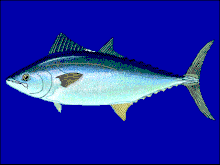
Mackerel is a common name applied to a number of different species of pelagic fish, mostly from the family Scombridae. They are found in both temperate and tropical seas, mostly living along the coast or offshore in the oceanic environment.
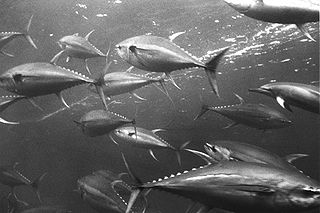
The mackerel, tuna, and bonito family, Scombridae, includes many of the most important and familiar food fishes. The family consists of 51 species in 15 genera and two subfamilies. All species are in the subfamily Scombrinae, except the butterfly kingfish, which is the sole member of subfamily Gasterochismatinae.

Herring are forage fish, mostly belonging to the family Clupeidae.

"Sardine" and "pilchard" are common names that refer to various small, oily forage fish in the herring family Clupeidae. The term "sardine" was first used in English during the early 15th century and may come from the Mediterranean island of Sardinia, around which sardines were once abundant.

Gadus is a genus of demersal fish in the family Gadidae, commonly known as cod, although there are additional cod species in other genera. The best known member of the genus is the Atlantic cod.

Bonitos are a tribe of medium-sized, ray-finned predatory fish in the family Scombridae – a family it shares with the mackerel, tuna, and Spanish mackerel tribes, and also the butterfly kingfish. Also called the tribe Sardini, it consists of eight species across four genera; three of those four genera are monotypic, having a single species each. Bonitos closely resemble the skipjack tuna.

The double-lined mackerel, is a species of Spanish mackerel in the family Scombridae. This species is sometimes also called the scad mackerel.
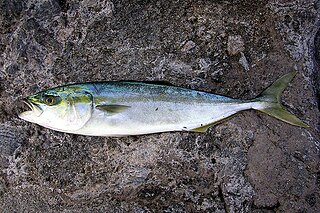
The Japanese amberjack or yellowtail, Seriola quinqueradiata, is a species of jack fish in the family Carangidae. It is native to the northwest Pacific Ocean, from Korea to Hawaii.
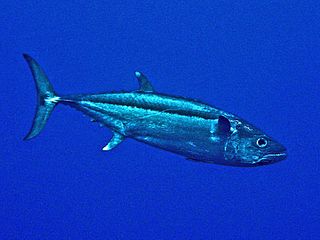
The dogtooth tunaGymnosarda unicolor, also known as white tuna, is a species of pelagic marine fish which belongs to the family Scombridae.

The Australian bonito, horse mackerel or little bonito, Sarda australis is a fish of the family Scombridae and is found in eastern Australia and New Zealand. They swim at depths reaching depths of approximately 30 m (98 ft), in open water. Its length is commonly at around 40–45 centimetres (16–18 in) fork length and 1.8–2.3 kilograms (4.0–5.1 lb) weight. Its maximum length and weight are about 100 centimetres (39 in) and 9.4 kilograms (21 lb), respectively.

The butterfly kingfish is an ocean-dwelling ray-finned bony fish in the mackerel family, Scombridae – a family which it shares with the tunas, mackerels, Spanish mackerels, and bonitos. Unlike the 50 species from those four tribes, however, this species is unique in that it is the only scombrid to be classified apart from the rest, into the subfamily Gasterochismatinae and genus Gasterochisma.
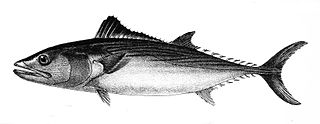
Sarda chiliensis, the eastern Pacific bonito, is a marine species of bonito. It ranges from Ecuador to Chile. Sarda lineolata, which ranges from Alaska to Mexico was formerly considered a subspecies, as Sarda chiliensis lineolata, but this treatment renders the species geographically disjunct.

The Atlantic bonito is a large mackerel-like fish of the family Scombridae. It is common in shallow waters of the Atlantic Ocean, the Mediterranean Sea, and the Black Sea, where it is an important commercial and game fish.

The greenback horse mackerel or greenback scad is a species of jack in the family Carangidae, found around western and southern Australia, and around New Zealand, from the surface to depths of 460 m. Its length is up to 64 cm.

The cero, also known as the pintado, kingfish, cero mackerel, or painted mackerel, is a ray-finned bony fish in the family Scombridae, better known as the mackerel family. More specifically, this fish is a member of the tribe Scomberomorini, the Spanish mackerels, and is the type species of the genus Scomberomorus. It is similar in appearance and coloration to the Atlantic Spanish mackerel, Scomberomorus maculatus, except the cero has a longitudinal stripe in addition to the spots of the Atlantic Spanish mackerel.

The West African Spanish mackerel is a species of fish in the family Scombridae.

An anchovy is a small, common forage fish of the family Engraulidae. Most species are found in marine waters, but several will enter brackish water, and some in South America are restricted to fresh water.
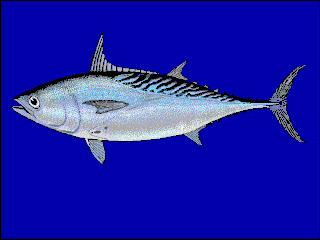
Euthynnus affinis, the mackerel tuna, kawakawa, little tuna or tongkol is a species of ray-finned bony fish in the family Scombridae, or mackerel family. It belongs to the tribe Thunnini, better known as the tunas. This is an Indo-Pacific species which is found from the Red Sea to French Polynesia.

The leaping bonito is a species of saltwater finfish from the Scombridae (Mackerel) family. Scombridae includes such tribes as the mackerels, tunas, and bonitos – the latter of which, the Sardini tribe, this fish is a member. It is the only member of the genus Cybiosarda, which is therefore called a monotypic taxon. Since the bonitos and tunas are close relatives, this fish has variously been referred to by such other common names as Australian tuna, striped bonito, and Watson's bonito.
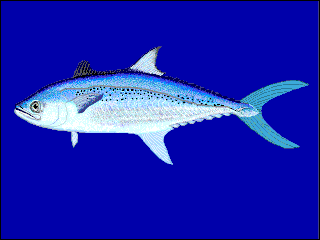
The Korean mackerel also known as the Korean seerfish, is a ray-finned bony fish in the family Scombridae, better known as the mackerel family. More specifically, this fish is a member of the tribe Scomberomorini, the Spanish mackerels. It has an Indo-Pacific distribution which extends from the east coast of India and Sri Lanka along the Asian continental shelf to Sumatra then north to Korea and Wakasa Bay in the Sea of Japan. This species is of minor commercial importance in some parts of its range where it is taken using gill nets and is marketed either fresh or dried-salted. The Korean mackerel is an important quarry species for the drift net fishery in Palk Bay and the Gulf of Mannar in India.
